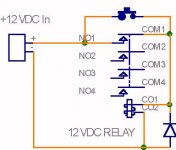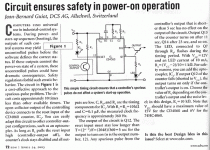Yesterday, at a local hi-fi dealer, I saw an amp with 2 buttons for "spaekers A" and "speakers B" selection
And I thought that this would be nice in our diy amps, to avoid the "bump" sound in the speakers, when we turn on the amps
When we turn the amp on, we would simply have to have the button unpressed, and after having turn it on, or after 15 minutes, we push the button to select the output on speakers A (or B if you have 2 pairs)
What dou you alle think of this?
And I thought that this would be nice in our diy amps, to avoid the "bump" sound in the speakers, when we turn on the amps
When we turn the amp on, we would simply have to have the button unpressed, and after having turn it on, or after 15 minutes, we push the button to select the output on speakers A (or B if you have 2 pairs)
What dou you alle think of this?
This is sometimes done automatically.
My Harman/Khardon Switches in the Speakers after
a delay of 6 seconds.
Of course you can do it manually.
Then you need no delay circuit. Only a manual switch.
But say your girlfriend uses your amplifier.
And does not remember to switch off,
we she turns off the amplifier.
So the switch is ON next time you switch on amplifier.
Or you yourself are drunk of drinking 10 beers.
And forget.
For me a turn on bump is no big problem.
I can live with it.
And it takes a lot more to destroy my speakers.
An automatical Relay is often used by the PROTECTION circuits
to switch away and save the speaker, if something wrong
or onormal happens.
So the Relay is there. Then the manufaturers only need to add
a simple delay circuit to make a slow start.
Delay:
It is a mostly a RC combination. A capacitor is slowly loaded via a currentlimiting resistor.
(you can say it is a RC-filter with very low frequency, f)
When voltage over the timing Capacitor
reaches a certain value, after a certain time,
a transistor switches the Output Relay to ON.
Time= RxC
seconds= Ohms x Farad
example:
22kohm x 100uF= 22000 x 0.000100 = 2.2 seconds
After 2.2 seconds the voltage over Capacitor is about 60% of the supply voltage.
/halo - poster without delay
My Harman/Khardon Switches in the Speakers after
a delay of 6 seconds.
Of course you can do it manually.
Then you need no delay circuit. Only a manual switch.
But say your girlfriend uses your amplifier.
And does not remember to switch off,
we she turns off the amplifier.
So the switch is ON next time you switch on amplifier.
Or you yourself are drunk of drinking 10 beers.
And forget.
For me a turn on bump is no big problem.
I can live with it.
And it takes a lot more to destroy my speakers.
An automatical Relay is often used by the PROTECTION circuits
to switch away and save the speaker, if something wrong
or onormal happens.
So the Relay is there. Then the manufaturers only need to add
a simple delay circuit to make a slow start.
Delay:
It is a mostly a RC combination. A capacitor is slowly loaded via a currentlimiting resistor.
(you can say it is a RC-filter with very low frequency, f)
When voltage over the timing Capacitor
reaches a certain value, after a certain time,
a transistor switches the Output Relay to ON.
Time= RxC
seconds= Ohms x Farad
example:
22kohm x 100uF= 22000 x 0.000100 = 2.2 seconds
After 2.2 seconds the voltage over Capacitor is about 60% of the supply voltage.
/halo - poster without delay
you're right
both designs have their own advantages and disadvantages
a manual button will need no added components (except wire and the button)
will probably sound better because of this
but if you forget to swich it off...
a relay is more "user friendly", but uses more parts
both designs have their own advantages and disadvantages
a manual button will need no added components (except wire and the button)
will probably sound better because of this
but if you forget to swich it off...
a relay is more "user friendly", but uses more parts
That would work except when you forgot to turn off the speaker switch. A better solution is one that automatically resets itself each time you turn off the power.
You can create a manual reset button easily with a relay and a momentary contact pushbutton. You will need a relay with at least 3 sets of contacts (5 would be better or you can use two relays to get extra contacts).
Wire power to the relay coil through a normally open contact of the relay and wire the push-button switch in parallel with the relay contact. When power is first applied the relay is de-energised. When you press the button, power flows through the relay coil, energizing the relay. At that point you can release the button and the relay will stay energised. Use the other relay contacts for your speaker wires.
Precautions:
For safety reasons and to reduce the chance of inducing AC mains noise into the speaker wiring, I suggest using a low voltage DC relay (12 VDC woul be a good choice) powered from a self contained wall transformer power supply (wall wart).
The diode is there to absorb back EMF generated when the relay is de-energised.
You can create a manual reset button easily with a relay and a momentary contact pushbutton. You will need a relay with at least 3 sets of contacts (5 would be better or you can use two relays to get extra contacts).
Wire power to the relay coil through a normally open contact of the relay and wire the push-button switch in parallel with the relay contact. When power is first applied the relay is de-energised. When you press the button, power flows through the relay coil, energizing the relay. At that point you can release the button and the relay will stay energised. Use the other relay contacts for your speaker wires.
Precautions:
For safety reasons and to reduce the chance of inducing AC mains noise into the speaker wiring, I suggest using a low voltage DC relay (12 VDC woul be a good choice) powered from a self contained wall transformer power supply (wall wart).
The diode is there to absorb back EMF generated when the relay is de-energised.
Attachments
If you are using banana plugs for your speaker cables, just unplug the +Ve speaker line each time before turn off power amp and plug it back in after turn on the amp, but leave the -Ve always plug in, this way no need to add extra components in the circuit, but if you tend to forget then the Velleman Kit is quite useful, I am using it and can not hear any degrade in sound quality yet. One solution I heard is to change/replace with new relay each year, say the same time that you replace the batteries for the smoke detectors to ensure fresh relay contacts.
IMHO
Chris
IMHO
Chris
Yes, and has the added advantage to let go current slowly to amp circuits avoiding thermal and electrical stresses.fezz said:i thought a current inrush limiter did the same thing?
Yes again. There are a few threads about all this you may want to check. One is "Amp speaker protection..." on the same page as this thread is.If it does, it is a much more appealing option to anything else as it does not get in the signal path.
ciao,
Roberto Amato
From EDN
www.ednmag.com is down this morning, so I scanned an article from the most recent issue which has an interesting "accidental trip" circuit:
www.ednmag.com is down this morning, so I scanned an article from the most recent issue which has an interesting "accidental trip" circuit:
Attachments
I added a switch and a power resistor.
I ran the output from the circuit boards of my V4's to a dual switch. One leg goes to the + speaker post. The other goes to a 25 watt Dale 1% power resistor. Then this goes to the - speaker post.
This will allow running in the amp for warm up without any output. The switch I used is a dual that is rated 10 amps 125v/6 amp 250v AC per side. With both sides tied together it should hold up very well. DC is harder on contacts than AC, but the capacitor coupled V4 should have very low DC.
George
I ran the output from the circuit boards of my V4's to a dual switch. One leg goes to the + speaker post. The other goes to a 25 watt Dale 1% power resistor. Then this goes to the - speaker post.
This will allow running in the amp for warm up without any output. The switch I used is a dual that is rated 10 amps 125v/6 amp 250v AC per side. With both sides tied together it should hold up very well. DC is harder on contacts than AC, but the capacitor coupled V4 should have very low DC.
George
thump
You can buy inrush resistors from Digikey.
They decline to .3 ohms or so (there are many values.) panasonic brand.
useful either at the line side or before the caps.
Most of us would prefer not to have failure prone contact devices on the high-current speaker side. Relays are fine if you can get at them and replace them from time to time!
Catalog page 731.
You can buy inrush resistors from Digikey.
They decline to .3 ohms or so (there are many values.) panasonic brand.
useful either at the line side or before the caps.
Most of us would prefer not to have failure prone contact devices on the high-current speaker side. Relays are fine if you can get at them and replace them from time to time!
Catalog page 731.
- Status
- This old topic is closed. If you want to reopen this topic, contact a moderator using the "Report Post" button.
- Home
- Amplifiers
- Pass Labs
- An idea for suppressing the turn-on "bump"

